Multidimensional Spatial Vitality Automated Monitoring Method for Public Open Spaces Based on Computer Vision Technology: Case Study of Nanjing’s Daxing Palace Square
Abstract
1. Introduction
2. Methods
2.1. Methodology Framework Overview
2.2. Study Site
2.3. Obtaining the Research Data
2.3.1. Quantification of Physical Site Environment
2.3.2. Obtaining Pedestrian Trajectory Data
2.4. Spatial Vitality Factors
2.4.1. Crowd Heat
2.4.2. Staying Behavior Ratio
2.4.3. Movement Speed
2.4.4. Spatial Participation
2.5. Manual Assessment of Spatial Vitality
2.6. Assessment Criteria
2.6.1. Crowd Heat
2.6.2. Staying Behavior Ratio
2.6.3. Movement Speed
2.6.4. Spatial Participation
2.7. Validation Process
2.7.1. Preparation Phase
2.7.2. Pre-Scoring Phase
2.7.3. Scoring Phase
2.7.4. Validation Phase
3. Results
3.1. Validation Results
3.2. Spatial Vitality Factor Analysis
3.2.1. Crowd Heat
3.2.2. Staying Behavior Ratio
3.2.3. Movement Speed
3.2.4. Spatial Participation
4. Discussion
5. Conclusions
Author Contributions
Funding
Data Availability Statement
Acknowledgments
Conflicts of Interest
References
- Ren, X. Combined effects of dominant sounds, conversational speech and multisensory perception on visitors’ acoustic comfort in urban open spaces. Landsc. Urban Plan. 2023, 232, 104674. [Google Scholar] [CrossRef]
- Scheiber, S. Re-designing urban open spaces to act as green infrastructure—The case of Malta. Transp. Res. Procedia 2022, 60, 148–155. [Google Scholar] [CrossRef]
- Hooper, P.; Boruff, B.; Beesley, B.; Badland, H.; Giles-Corti, B. Testing spatial measures of public open space planning standards with walking and physical activity health outcomes: Findings from the Australian national liveability study. Landsc. Urban Plan. 2018, 171, 57–67. [Google Scholar] [CrossRef]
- Wang, A.; Ho, D.C.W.; Lai, L.W.C.; Chau, K.W. Public preferences for government supply of public open space: A neo-institutional economic and lifecycle governance perspective. Cities 2023, 141, 104463. [Google Scholar] [CrossRef]
- Mu, B.; Mayer, A.L.; He, R.; Tian, G. Land use dynamics and policy implications in Central China: A case study of Zhengzhou. Cities 2016, 58, 39–49. [Google Scholar] [CrossRef]
- Zheng, W.; Shen, G.Q.; Wang, H.; Hong, J.; Li, Z. Decision support for sustainable urban renewal: A multi-scale model. Land Use Policy 2017, 69, 361–371. [Google Scholar] [CrossRef]
- Xie, D.; Fan, J.; Chang, J. From space reproduction to place-making: The new trend of China’s urban regeneration. Urban Dev. Stud. 2017, 24, 110–115. [Google Scholar]
- Ma, L.; Shi, W.; Wu, L. Mediating roles of perceptions and visiting behavior in the relationship between urban greenspace accessibility and personal health: Evidence from Lanzhou, China. Appl. Geogr. 2023, 159, 103085. [Google Scholar] [CrossRef]
- Xia, H.; Yin, R.; Xia, T.; Zhao, B.; Qiu, B. People-Oriented: A Framework for Evaluating the Level of Green Space Provision in the Life Circle from a Supply and Demand Perspective: A Case Study of Gulou District, Nanjing, China. Sustainability 2024, 16, 955. [Google Scholar] [CrossRef]
- Wang, N.; Zhao, Y. Construction of an ecological security pattern in Jiangnan water network area based on an integrated Approach: A case study of Gaochun, Nanjing. Ecological Indicators 2024, 158, 111314. [Google Scholar] [CrossRef]
- Chen, J.; Chen, L.; Li, Y.; Zhang, W.; Long, Y. Measuring Physical Disorder in Urban Street Spaces: A Large-Scale Analysis Using Street View Images and Deep Learning. Ann. Am. Assoc. Geogr. 2023, 113, 469–487. [Google Scholar] [CrossRef]
- Ding, P.; Jensen, F.S.; Carstensen, T.A.; Jorgensen, G. Exploring adults’ passive experience of children playing in cities: Case study of five urban public open spaces in Copenhagen, Denmark. Cities 2023, 136, 104250. [Google Scholar] [CrossRef]
- Zhu, W.; Wang, J.; Qin, B. Quantity or quality? Exploring the association between public open space and mental health in urban China. Landsc. Urban Plan. 2021, 213, 104128. [Google Scholar] [CrossRef]
- Jacobs, J. The Death and Life of Great American Cities; Random House: New York, NY, USA, 1961. [Google Scholar]
- Liu, S.; Lai, S.-Q.; Liu, C.; Li, J. What influenced the vitality of the waterfront open space? A case study of Huangpu River in Shanghai, China. Cities 2021, 114, 103197. [Google Scholar] [CrossRef]
- Zhang, L.; Zhang, R.; Yin, B. The impact of the built-up environment of streets on pedestrian activities in the historical area. Alex. Eng. J. 2021, 60, 285–300. [Google Scholar] [CrossRef]
- Gehl, J. Life between Buildings; Van Nostrand Reinhold: New York, NY, USA, 1987. [Google Scholar]
- Jia, C.; Liu, Y.; Du, Y.; Huang, J.; Fei, T. Evaluation of Urban Vibrancy and Its Relationship with the Economic Landscape: A Case Study of Beijing. Isprs. Int. J. Geo-Inf. 2021, 10, 72. [Google Scholar] [CrossRef]
- Miranda, A.S.; Fan, Z.; Duarte, F.; Ratti, C. Desirable streets: Using deviations in pedestrian trajectories to measure the value of the built environment. Comput. Environ. Urban Syst. 2021, 86, 101563. [Google Scholar] [CrossRef]
- Delclos-Alio, X.; Gutierrez, A.; Miralles-Guasch, C. The urban vitality conditions of Jane Jacobs in Barcelona: Residential and smartphone-based tracking measurements of the built environment in a Mediterranean metropolis. Cities 2019, 86, 220–228. [Google Scholar] [CrossRef]
- Wu, J.; Ta, N.; Song, Y.; Lin, J.; Chai, Y. Urban form breeds neighborhood vibrancy: A case study using a GPS-based activity survey in suburban Beijing. Cities 2018, 74, 100–108. [Google Scholar] [CrossRef]
- Hahm, Y.; Yoon, H.; Choi, Y. The effect of built environments on the walking and shopping behaviors of pedestrians; A study with GPS experiment in Sinchon retail district in Seoul, South Korea. Cities 2019, 89, 1–13. [Google Scholar] [CrossRef]
- Sulis, P.; Manley, E.; Zhong, C.; Batty, M. Using mobility data as proxy for measuring urban vitality. J. Spat. Inf. Sci. 2018, 2018, 137–162. [Google Scholar] [CrossRef]
- Meng, Y.; Xing, H. Exploring the relationship between landscape characteristics and urban vibrancy: A case study using morphology and review data. Cities 2019, 95, 102389. [Google Scholar] [CrossRef]
- Wu, C.; Ye, X.; Ren, F.; Du, Q. Check-in behaviour and spatio-temporal vibrancy: An exploratory analysis in Shenzhen, China. Cities 2018, 77, 104–116. [Google Scholar] [CrossRef]
- Yue, W.; Chen, Y.; Zhang, Q.; Liu, Y. Spatial Explicit Assessment of Urban Vitality Using Multi-Source Data: A Case of Shanghai, China. Sustainability 2019, 11, 638. [Google Scholar] [CrossRef]
- Zhu, J.; Lu, H.; Zheng, T.; Rong, Y.; Wang, C.; Zhang, W.; Yan, Y.; Tang, L. Vitality of Urban Parks and Its Influencing Factors from the Perspective of Recreational Service Supply, Demand, and Spatial Links. Int. J. Environ. Res. Public Health 2020, 17, 1615. [Google Scholar] [CrossRef] [PubMed]
- Smith, R.; Miller, K. Ecocity Mapping Using GIS: Introducing a Planning Method for Assessing and Improving Neighborhood Vitality. Prog. Community Health Partnersh. Res. Educ. Action 2013, 7, 95–106. [Google Scholar] [CrossRef] [PubMed]
- Niu, T.; Qing, L.; Han, L.; Long, Y.; Hou, J.; Li, L.; Tang, W.; Teng, Q. Small public space vitality analysis and evaluation based on human trajectory modeling using video data. Build. Environ. 2022, 225, 109563. [Google Scholar] [CrossRef]
- Mu, B.; Liu, C.; Mu, T.; Xu, X.; Tian, G.; Zhang, Y.; Kim, G. Spatiotemporal fluctuations in urban park spatial vitality determined by on-site observation and behavior mapping: A case study of three parks in Zhengzhou City, China. Urban For. Urban Green. 2021, 64, 127246. [Google Scholar] [CrossRef]
- Pakoz, M.Z.; Isik, M. Rethinking urban density, vitality and healthy environment in the post-pandemic city: The case of Istanbul. Cities 2022, 124, 103598. [Google Scholar] [CrossRef]
- Jalaladdini, S.; Oktay, D. Urban Public Spaces and Vitality: A Socio-Spatial Analysis in the Streets of Cypriot Towns. In Proceedings of the Asia Pacific International Conference on Environment-Behaviour Studies (AicE-Bs), Eastern Mediterranean Univ (EMU), Urban Res & Dev Ctr (URDC), Famagusta, Cyprus, 7–9 December 2012; pp. 664–674. [Google Scholar]
- Marquet, O.; Miralles-Guasch, C. The Walkable city and the importance of the proximity environments for Barcelona’s everyday mobility. Cities 2015, 42, 258–266. [Google Scholar] [CrossRef]
- Veitch, J.; Carver, A.; Abbott, G.; Giles-Corti, B.; Timperio, A.; Salmon, J. How active are people in metropolitan parks? An observational study of park visitation in Australia. BMC Public Health 2015, 15, 610. [Google Scholar] [CrossRef]
- Hu, X.; Shen, P.; Shi, Y.; Zhang, Z. Using Wi-Fi probe and location data to analyze the human distribution characteristics of green spaces: A case study of the Yanfu Greenland Park, China. Urban For. Urban Green. 2020, 54, 126733. [Google Scholar] [CrossRef]
- Whyte, W.H. The Social Life of Small Urban Spaces; Conservation Foundation: Washington, DC, USA, 1980. [Google Scholar]
- Su, J.; He, X.; Qing, L.; Niu, T.; Cheng, Y.; Peng, Y. A novel social distancing analysis in urban public space: A new online spatio-temporal trajectory approach. Sustain. Cities Soc. 2021, 68, 102765. [Google Scholar] [CrossRef] [PubMed]
- Hou, J.; Chen, L.; Zhang, E.; Jia, H.; Long, Y. Quantifying the usage of small public spaces using deep convolutional neural network. PLoS ONE 2020, 15, e0239390. [Google Scholar] [CrossRef] [PubMed]
- Wong, P.K.-Y.; Luo, H.; Wang, M.; Leung, P.H.; Cheng, J.C.P. Recognition of pedestrian trajectories and attributes with computer vision and deep learning techniques. Adv. Eng. Inform. 2021, 49, 101356. [Google Scholar] [CrossRef]
- Loo, B.P.Y.; Fan, Z. Social interaction in public space: Spatial edges, moveable furniture, and visual landmarks. Environ. Plan. B-Urban Anal. City Sci. 2023, 50, 2510–2526. [Google Scholar] [CrossRef]
- Wei, W.; Deng, Y.; Huang, L.; Chen, S.; Li, F.; Xu, L. Environment-deterministic pedestrian behavior? New insights from surveillance video evidence. Cities 2022, 125, 103638. [Google Scholar] [CrossRef]
- Hsu, W.T.; Ma, H.; Bai, N. The Influence of Spatial Vitality Around Subway Stations in Beijing on Pedestrians’ Emotion. In Proceedings of the 13th International Symposium for Environment-Behavior Studies (EBRA), Wuhan, China, 3–4 November 2018. [Google Scholar]
- Ma, X.; Ma, C.; Wu, C.; Xi, Y.; Yang, R.; Peng, N.; Zhang, C.; Ren, F. Measuring human perceptions of streetscapes to better inform urban renewal: A perspective of scene semantic parsing. Cities 2021, 110, 103086. [Google Scholar] [CrossRef]
- Marcus, C.; Francis, C. People Places: Design Guidelines for Urban Open Space; John Wiley: New York, NY, USA, 1998. [Google Scholar]
- Gehl, J.; Svarre, B. How to Study Public Life; Island Press: Washington, DC, USA, 2013. [Google Scholar]
- Rutledge, A.J. A Visual Approach to Park Design; Garland STPM Press: New York, NY, USA, 1982. [Google Scholar]
- Helbing, D.; Molnar, P. Social force model for pedestrian dynamics. Phys. Rev. E 1995, 51, 4282. [Google Scholar] [CrossRef]
- Williams, S.; Ahn, C.; Gunc, H.; Ozgirin, E.; Pearce, M.; Xiong, Z. Evaluating sensors for the measurement of public life: A future in image processing. Environ. Plan. B-Urban Anal. City Sci. 2019, 46, 1534–1548. [Google Scholar] [CrossRef]
- Fleiss, J.L.; Levin, B.; Paik, M.C. Statistical Methods for Rates and Proportions; John Wiley & SonsJohn Wiley & Sons: New York, NY, USA, 2003. [Google Scholar]
- Ewing, R.; Clemente, O.; Neckerman, K.M.; Purciel-Hill, M.; Quinn, J.W.; Rundle, A. Measuring Urban Design: Metrics for Livable Places; Island Press: Washington, DC, USA, 2013. [Google Scholar]
- Cao, J.; Kang, J. Social relationships and patterns of use in urban public spaces in China and the United Kingdom. Cities 2019, 93, 188–196. [Google Scholar] [CrossRef]

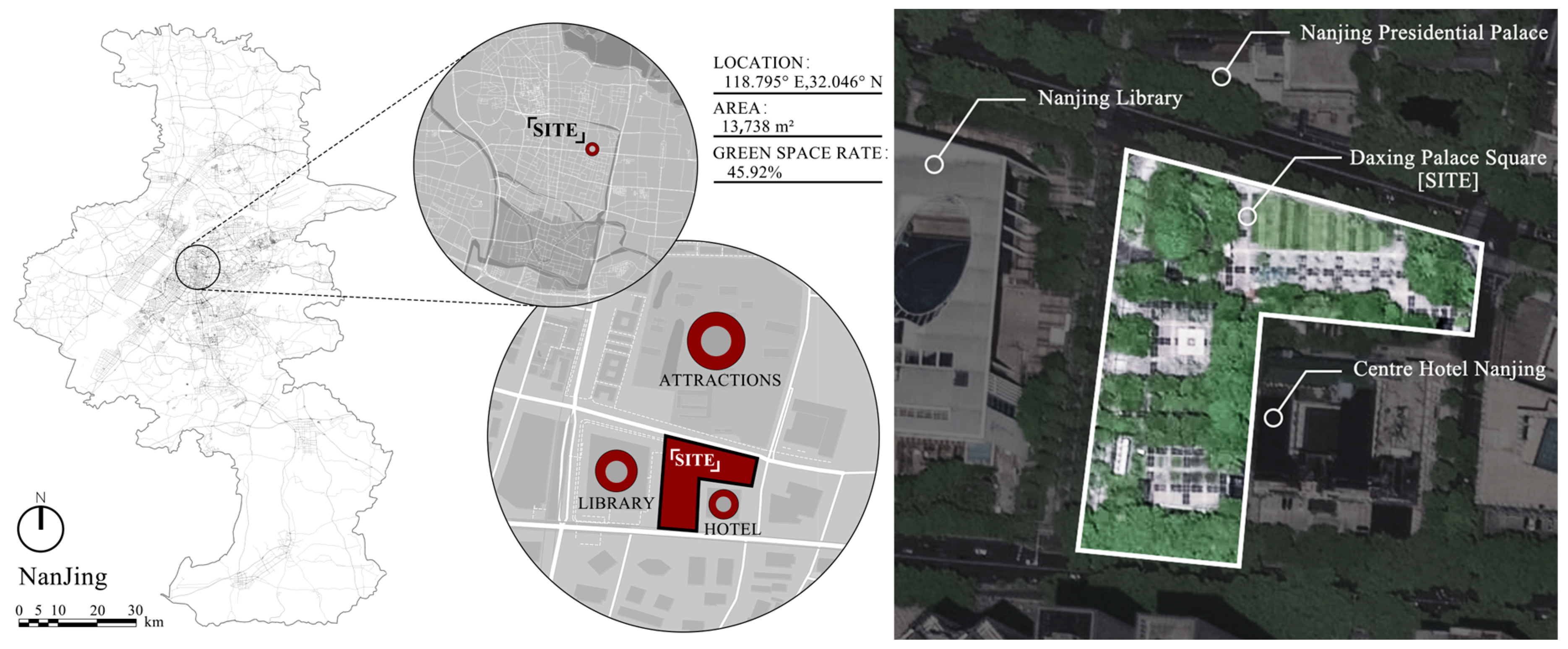

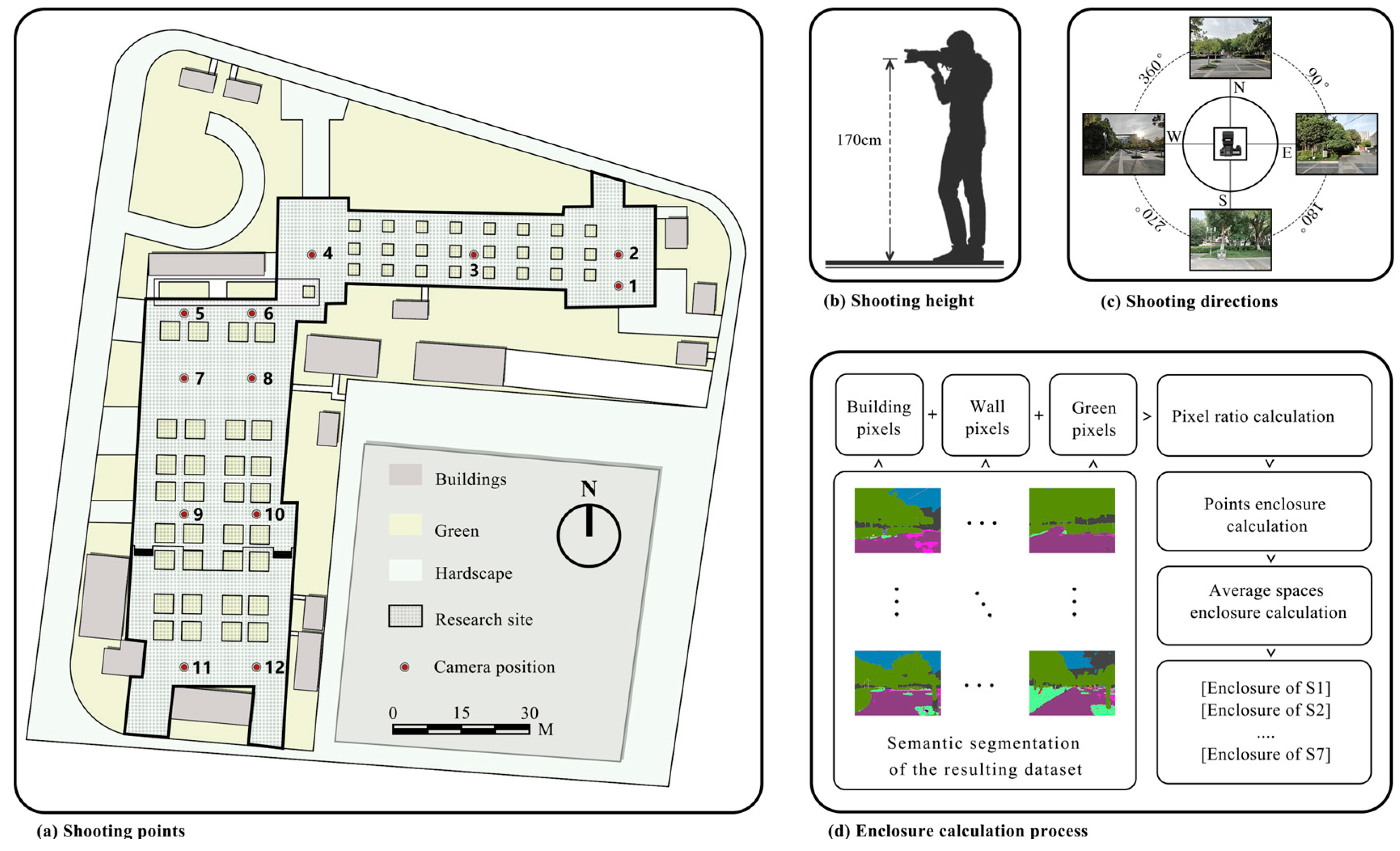
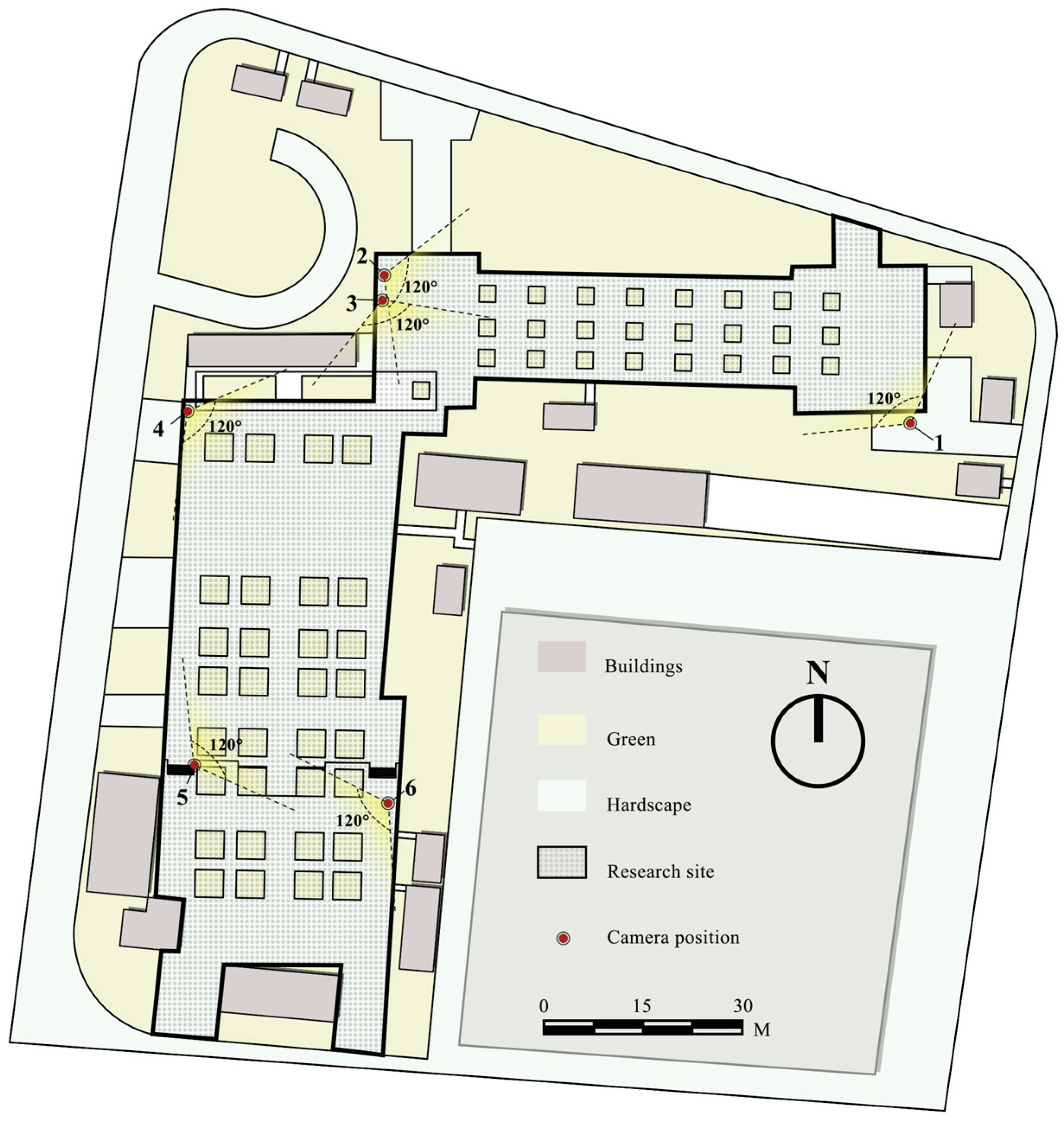
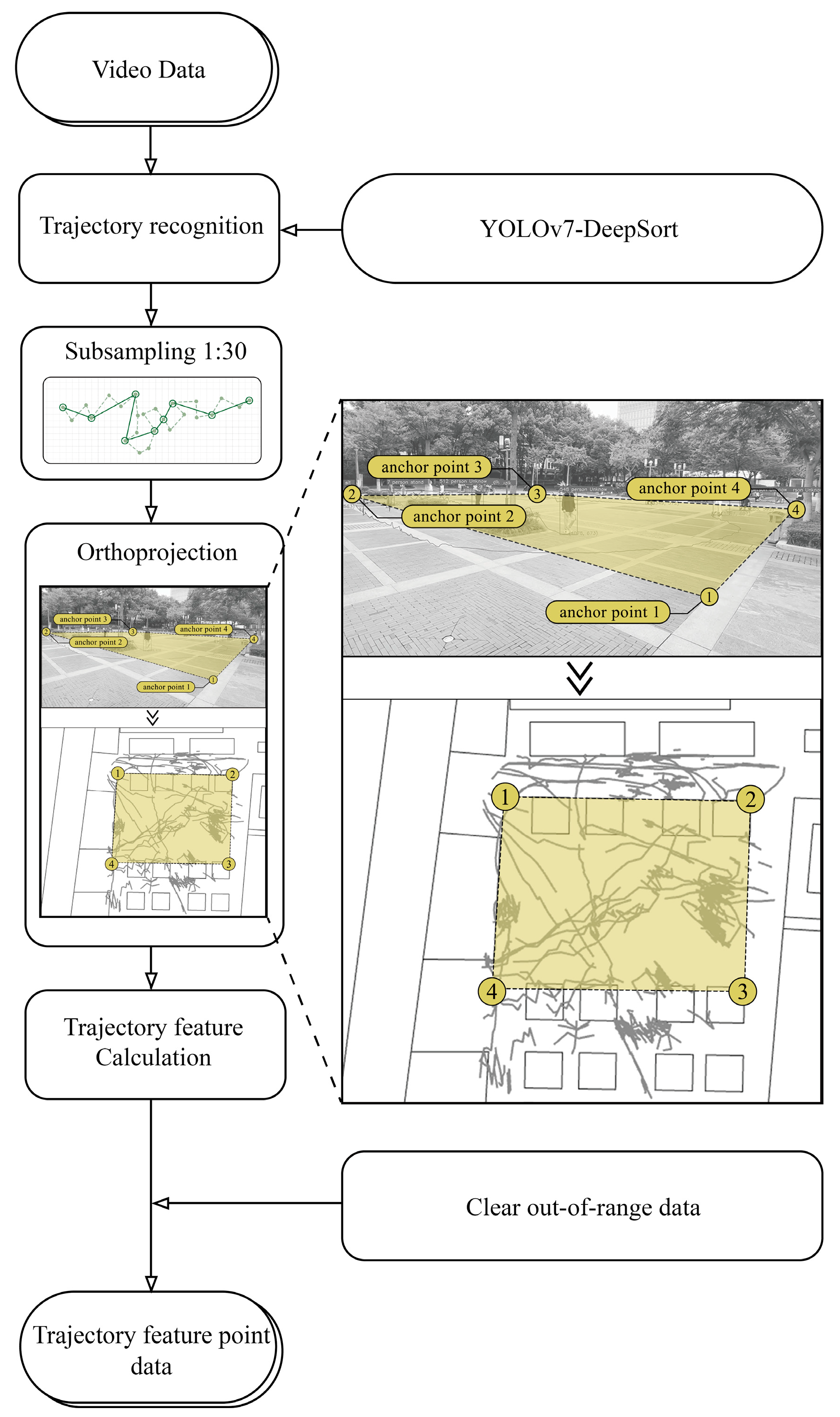

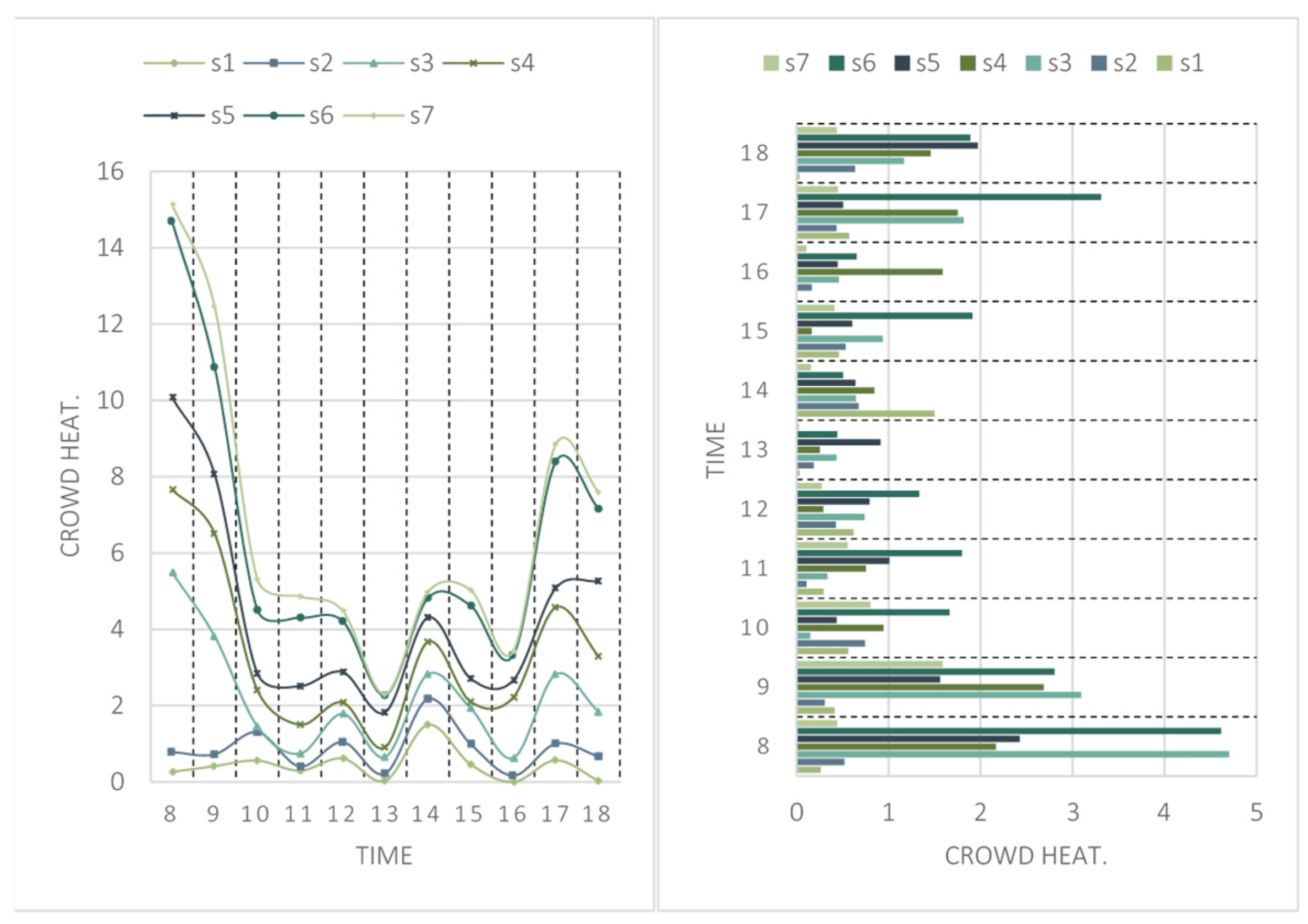
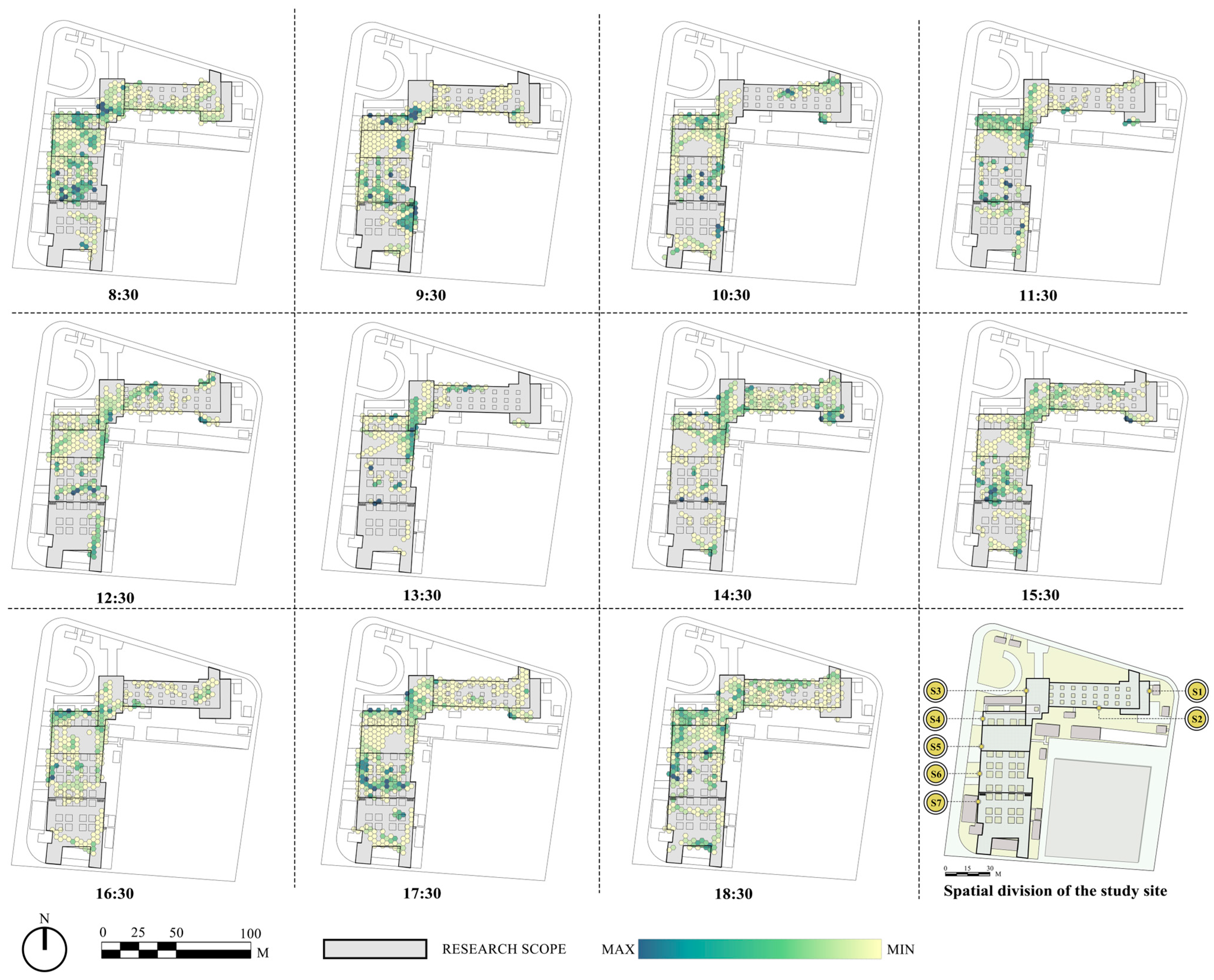
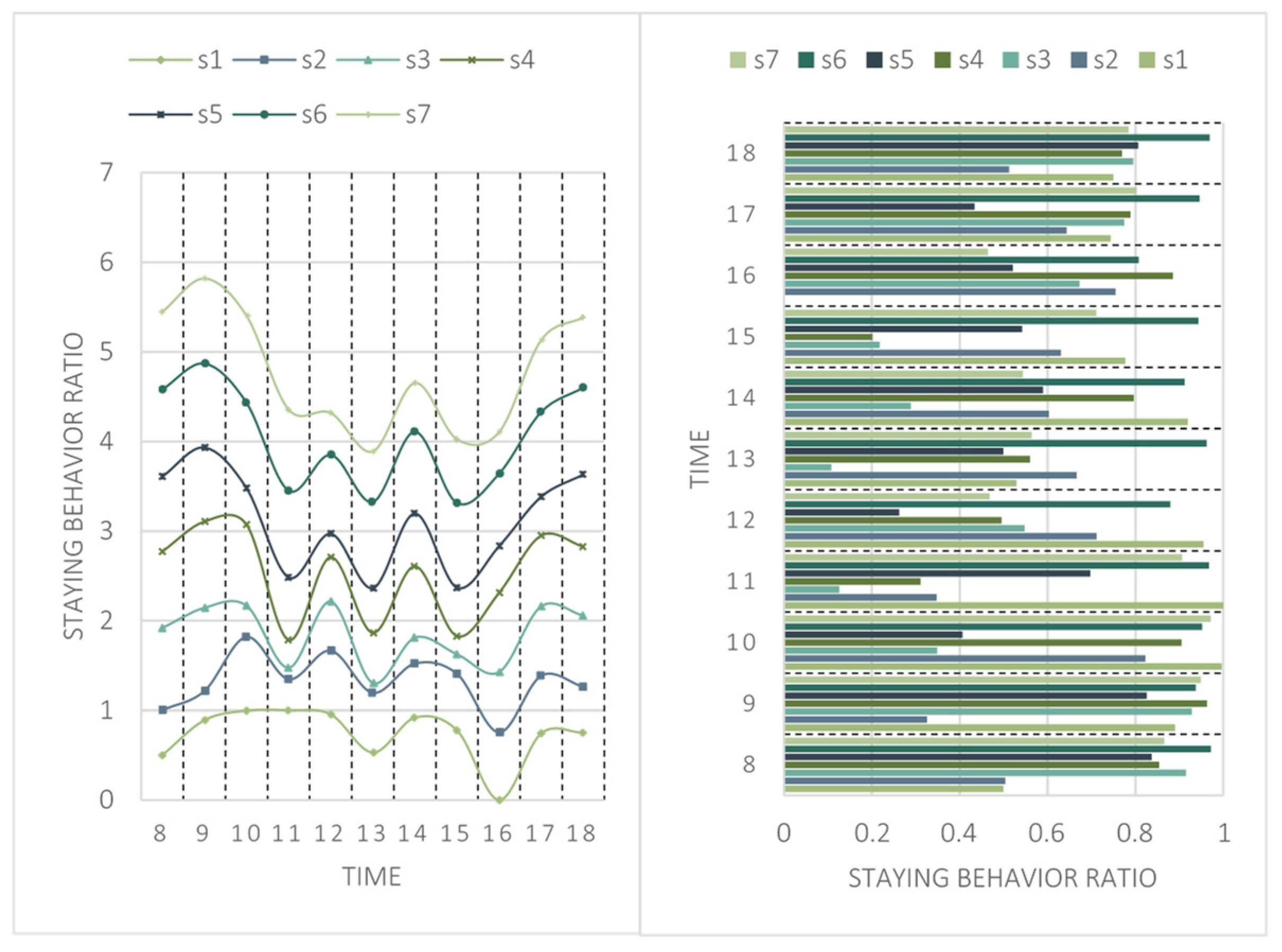
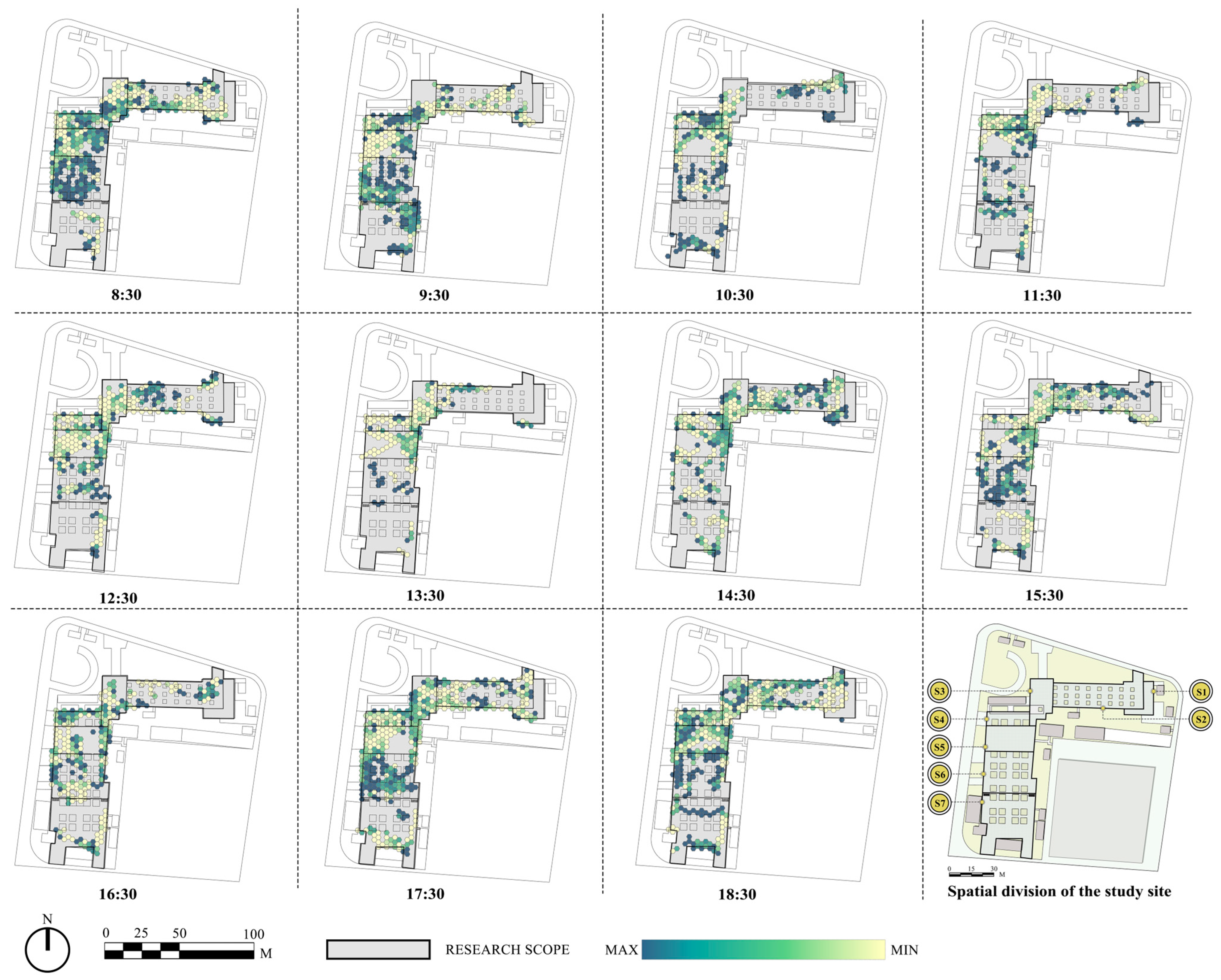




| Space | Spatial Features | Scenery | ||
|---|---|---|---|---|
| Area (m²) | Enclosure (%) | Rest Facilities | ||
| s1 | 297 | 52.38 | None | 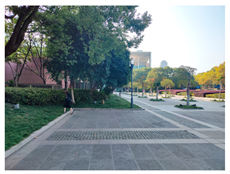 |
| s2 | 1244 | 46.50 | None | 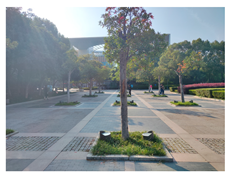 |
| s3 | 471 | 52.00 | None | 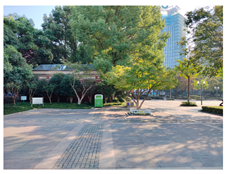 |
| s4 | 310 | 62.88 | Benches - 4 |  |
| s5 | 685 | 53.38 | None | 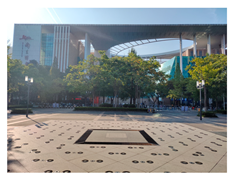 |
| s6 | 1141 | 67.38 | Benches - 13 |  |
| s7 | 1434 | 55.25 | None | 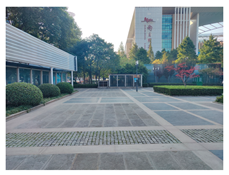 |
| Grade | Description |
|---|---|
| 1 | Few people |
| 2 | Relatively few people |
| 3 | Moderate number of people |
| 4 | Relatively many people |
| 5 | Many people |
| Grade | Description |
|---|---|
| 1 | Almost all crowd behaviors are non-staying |
| 2 | Most crowd behaviors are non-staying, and more than half of the staying people have short stay times (less than 1 min) |
| 3 | Most crowd behaviors are non-staying, with more than half of the staying people having longer stay times (over 1 min); most crowd behaviors are staying, and more than half of the staying people have shorter stay times (less than 1 min) |
| 4 | Most crowd behaviors are staying, and more than half of the staying people have longer stay times (over 1 min) |
| 5 | Almost all crowd behaviors are staying |
| Grade | Description |
|---|---|
| 1 | Most crowd behaviors have slow movement speeds |
| 2 | Most crowd behaviors have relatively slow movement speeds |
| 3 | The proportion of crowd behaviors with different movement speeds is balanced |
| 4 | Most crowd behaviors have relatively fast movement speeds |
| 5 | Most crowd behaviors have fast movement speeds |
| Grade | Description |
|---|---|
| 1 | Most crowd behaviors have weak interactions with space, with few or no social behaviors |
| 2 | Most crowd behaviors have moderate interactions with space, with relatively few social behaviors |
| 3 | Most crowd behaviors have moderate interactions with space, with a moderate number of social behaviors |
| 4 | Most crowd behaviors have strong interactions with space, with relatively many social behaviors |
| 5 | Most crowd behaviors have strong interactions with space, with many social behaviors |
| Spatial Vitality Indicators | Human Evaluation Agreement (Absolute Agreement) | Machine Monitoring vs. Human Evaluation (Absolute Agreement) | Machine Monitoring vs. Human Evaluation (Consistency) | |||
|---|---|---|---|---|---|---|
| ICC | p | ICC | p | ICC | p | |
| Crowd heat | 0.763 | <0.001 | 0.512 | <0.001 | 0.719 | <0.001 |
| Staying behavior ratio | 0.820 | <0.001 | 0.549 | <0.001 | 0.812 | <0.001 |
| Movement speed | 0.794 | <0.001 | 0.612 | <0.001 | 0.628 | <0.001 |
| Spatial participation | 0.748 | <0.001 | 0.584 | <0.001 | 0.660 | <0.001 |
Disclaimer/Publisher’s Note: The statements, opinions and data contained in all publications are solely those of the individual author(s) and contributor(s) and not of MDPI and/or the editor(s). MDPI and/or the editor(s) disclaim responsibility for any injury to people or property resulting from any ideas, methods, instructions or products referred to in the content. |
© 2024 by the authors. Licensee MDPI, Basel, Switzerland. This article is an open access article distributed under the terms and conditions of the Creative Commons Attribution (CC BY) license (https://creativecommons.org/licenses/by/4.0/).
Share and Cite
Hu, X.; Shen, X.; Shi, Y.; Li, C.; Zhu, W. Multidimensional Spatial Vitality Automated Monitoring Method for Public Open Spaces Based on Computer Vision Technology: Case Study of Nanjing’s Daxing Palace Square. ISPRS Int. J. Geo-Inf. 2024, 13, 48. https://doi.org/10.3390/ijgi13020048
Hu X, Shen X, Shi Y, Li C, Zhu W. Multidimensional Spatial Vitality Automated Monitoring Method for Public Open Spaces Based on Computer Vision Technology: Case Study of Nanjing’s Daxing Palace Square. ISPRS International Journal of Geo-Information. 2024; 13(2):48. https://doi.org/10.3390/ijgi13020048
Chicago/Turabian StyleHu, Xinyu, Ximing Shen, Yi Shi, Chen Li, and Wei Zhu. 2024. "Multidimensional Spatial Vitality Automated Monitoring Method for Public Open Spaces Based on Computer Vision Technology: Case Study of Nanjing’s Daxing Palace Square" ISPRS International Journal of Geo-Information 13, no. 2: 48. https://doi.org/10.3390/ijgi13020048
APA StyleHu, X., Shen, X., Shi, Y., Li, C., & Zhu, W. (2024). Multidimensional Spatial Vitality Automated Monitoring Method for Public Open Spaces Based on Computer Vision Technology: Case Study of Nanjing’s Daxing Palace Square. ISPRS International Journal of Geo-Information, 13(2), 48. https://doi.org/10.3390/ijgi13020048





